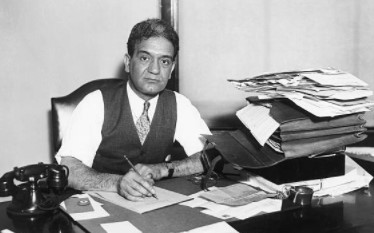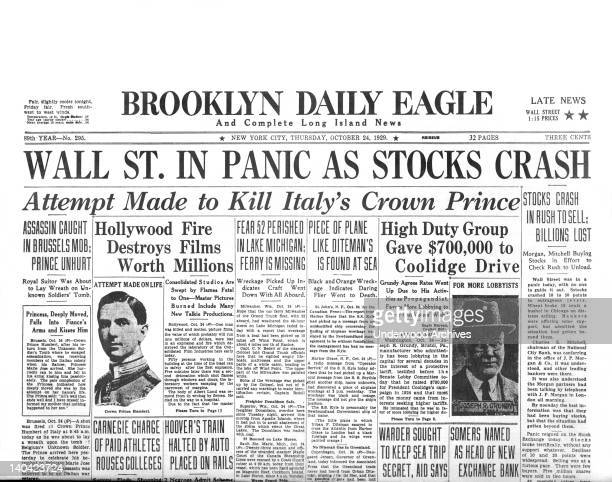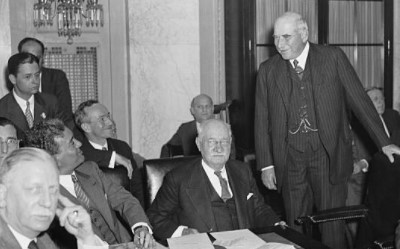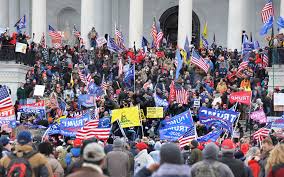
Allow me to relate the history of the 1934 Pecora Report. Back in 1929, America was suffering from the Great Depression’s effects and a great crisis of confidence in our financial systems. Our predecessors demanded not just an investigation into the system’s failure but the transparency of the probe’s findings and action on the part of Congress that would address and nullify the deviant practices that led to our economy’s collapse. As I recount this remarkable story of reflection and change in America’s history, I ask that you see the potential parallels to the 2016 Mueller Report on election interference and the current crisis of confidence facing our electoral system.

Following the devastating Stock Market Crash of 1929, President Herbert Hoover was frustrated that the New York Stock Exchange had not taken more decisive self-regulatory action to report market abuses. This led Hoover to support a ground-breaking 1932 congressional investigation into market manipulations he believed had contributed to the crash. Newly-elected President Roosevelt continued the cause the following year. The investigation came to be known as ‘The Pecora Report’ after Ferdinand Pecora, a “gangster-style” Assistant District Attorney for New York County, was hired to complete the investigation and draft the final report in 1933. The Pecora Commission subpoenaed corporate records and heard testimony from hundreds of witnesses, producing nearly 12,000 pages of transcripts from more than 100 hearings. The investigative staff of lawyers, accountants, and statisticians conducted scores of interviews and sworn depositions leading to findings that condemned Wall Street’s major players at the Time—men the American public had formally deemed untouchable.
The enormous sampling of Wall Street Banks included in the Pecora Report showed that Wall Street’s corruption was not limited to just a few actors but rather permeated the entire institution and just about every bank connected to it. The overall conclusion was that these actors could determine who did and did not earn money and who made entire fortunes off the working class’s meager investments. As a former bank examiner, I can tell you that the processes they used were detailed and based on learned objectives, not merely fluke chance. The banks knew exactly what they were doing and how they were doing it. Their weakness was that they underestimated the American people and the electoral process. They did not count on the revelatory investigation that was the Pecora Report.
Although the hearings were criticized by Democratic Party members and their supporters at the Time for being little more than an attempt by Republicans to appease the growing demands of an angry American public suffering through the Great Depression, The Pecora Report found rampant stock manipulation, insider trading and conflicts of interest, failure to disclose risks, interest-free loans to management, pay and bonus structure incentivizing the riskiest investments, and brazen tax evasion.

Pecora found that Wall Street would package and sell stocks that had been manipulated in their value. Bankers would knowingly sell stock that was over-valued and then pockets the massive profits while the ‘non-preferred’ investors suffered enormous losses. For example, under CEO Charles Mitchell, National City Bank (to become Citi Bank) conspired with the Anaconda Copper Company to defraud the public into over $150 million in losses. The scheme set up a ‘joint account’ of nearly 1.5 million shares of Anaconda Copper Company stock only valued at $4 per share, given the company’s near-bankrupt status. The stock was then repackaged and aggressively advertised, and sold through its salesmen through the National City affiliate. National City then pushed the newly repackaged stock from $40 to $128 in 3 months and then dumped the stock. In the end, the stock was only worth $4, and the massive losses were absorbed by the working-class clients of National City Bank.
The issue of insider trading and the conflicts of interest that Pecora uncovered raised a question of fairness. Should the wealthy class and its colluding politicians and judicial members be able to make large sums of money based on inside knowledge, or should all people have equal access to the same information when making investment decisions? Chase National Bank CEO Albert Wiggin was found to have accepted millions in stock from clients at discounted values. When questioned, Wiggin responded, “I assumed it was a favor, and I was very glad to take it.” Pecora also uncovered J. P. Morgan’s ‘preferred list’ of influential friends, including former US President Calvin Coolidge and Supreme Court Justice Owen J. Roberts. These select few participated in stock offerings at steeply discounted rates. They were necessarily granted access to untold wealth as long as they colluded with the corporation’s unfettered access to profits.
Failure to disclose risks was one of the most pervasive findings. Pecora saw that Wall Street Bankers went to great lengths to hide or exaggerate actual stock values and what investments actually contained, especially considering pending risks such as litigation or loss of value. Specifically, Pecora found that executives at National City Bank under CEO Charles Mitchell committed outright fraud in preparing stock release information.
Another pernicious practice discovered by Pecora was the interest-free loans to which bank managers helped themselves. Wall Street Bankers lent themselves millions of dollars of interest-free money from its clients’ savings accounts and used that money to gamble in the stock market. This corrupt practice essentially stole millions in savings without any repercussions. In contrast, the stock purchase plan available to lower-level employees at National City Bank required employees to pay top-dollar for shares. Worse yet, the purchase money for those shares was withheld from employee pay, essentially making them indentured servants. Employees were even required to reimburse the plan for any loss in stock value.
Findings went on to show that excessive salaries and bonuses were paid to Wall Street bank executives for pressuring salesmen to push the riskiest stocks. This meant sales clerks were filling client portfolios with volatile stocks in exchange for massive cash bonuses, and pay for salesman did not meet correct profitability guidelines as pay scales were based on the volume of fraudulently valued stocks salespeople moved rather than real generated wealth. Pecora found this made massive but unsustainable profits for the banks. Inevitably, the stocks would either fail to perform or crash altogether, losing large sums of money for clients utterly ignorant of how their portfolios were created or how their financial advisor was being compensated. To Pecora, this was “a gigantic foolproof device for gambling freely with the stockholders’ money, taking huge profits when the gamble won and risking not a penny of their own money if they lost.”
Finally, Pecora revealed that the giants of Wall Street were guilty of massive tax evasion, with most responding that they “hadn’t even filed their return in years.” J.P. Morgan and Company paid no income tax from 1930-1932, and none of the bank’s partners had paid their individual income taxes. In fact, hearings established that the total taxes paid by the entire house of Morgan and its partners in the previous five years was a single payment of $5000 in 1931. Arthur William Cutten, a commodity speculator with a seat on the Chicago Board of Trade, had not paid or filed a tax return in years, and despite making more than $1 million in bonuses in 1929, National City Bank CEO Charles Mitchell had paid no taxes due to losses incurred from the sale of diminished National City stock. Furthermore, Mitchell didn’t even file returns for the previous four years under the ruse of a fictitious loan of $2.8 million from the National City Company.
Pecora’s efforts led to a smattering of legal action against several Wall Street Tycoons. Although Charles Mitchell was acquitted of numerous charges, including tax evasion, he lost a multimillion-dollar civil lawsuit. Head of the New York Stock Exchange, Richard Whitney, served three years in federal prison for embezzlement. Chase National Bank head, Albert Wiggin, was found guilty of using shell companies to short his own bank’s stock. He served no jail time. Arthur Cutten, a renowned commodities speculator, was released by the US Supreme Court on the most egregious allegation of market manipulation. He died while awaiting trial for tax evasion.
Possibly the most significant finding of the Pecora report, however, was that bankers had not really broken any rules because we lacked a system of rules to hold them accountable in the first place. This created outrage and demand for Wall Street reform, leading Congress to found The Securities and Exchange Commission (SEC) and task it with regulating the stock market and protecting investors. Congress even moved to adopt Generally Accepted Accounted Principles (GAAP), the federal standard for accounting principles in the United States. These standards were the first line of defense against the government and business corruption by standardizing how assets were valued, and credit was granted. Congress created the Federal Deposit Insurance Corporation (FDIC), which provided regulation of deposit accounts and provided insurance for them as well. Finally, Congress passed the Glass-Steagall Act, also known as the Securities Act of 1933, and amended the Securities Exchange Act of 1934, which among other things, separated commercial and investment banking. These laws meant that checking accounts could no longer be used as an investment account for fund managers.
All this was meant to combat the finding that Pecora himself described in a 1933 New York Times article, “how men of might-not because of principle but because of economic power and wealth-have by the waving of a hand and adoption of a resolution taken millions and millions of the hard-earned pennies of the people and turned them into gold for themselves.”
The plans and framework put forth by Roosevelt’s think-tank based on Pecora Report findings set the foundation for legislation that would protect the American banking and investing institutions for the next 75 years. These lawmakers lived through the most devastating financial collapse in history and responded by intensely scrutinizing the men and institutions surrounding that economic failure. Their courage to investigate the cause of the financial meltdown and persistence in holding the major players accountable and creating new institutions and laws to protect against future calamity should not only be admired but emulated.

Today we face a crisis of confidence in our electoral system. We have a unique and vital opportunity to learn from the Pecora Report. Full, transparent release of the complete Mueller Report can allow ‘we the people’ to determine if and how to push our congressional representatives to make necessary changes and enact effective legislation to restore functioning, a credible electoral system, and much-needed public trust.
Bibliography
• The bulk of primary materials are on file at:
https://www.senate.gov/about/powers-procedures/investigations/pecora.htm
• Pecora, Ferdinand (1970) [First published 1939]. Wall Street Under Oath: The Story of Our Modern Money Changers. A. M. Kelley. ISBN 978-0-678-00372-5.
• Ritchie, Donald A. (1975). “The Pecora Wall Street Expose”. In Schlesinger, Arthur M., Jr.; Bruns, Roger. Congress Investigates A Documented History 1792-1974. 4. Chelsea House. ISBN 978-0-8352-0814-7.
• Perino, Michael (2010). The Hellhound of Wall Street: How Ferdinand Pecora’s Investigation of the Great Crash Forever Changed American Finance. The Penguin Press HC. ISBN 1-59420-272-9.